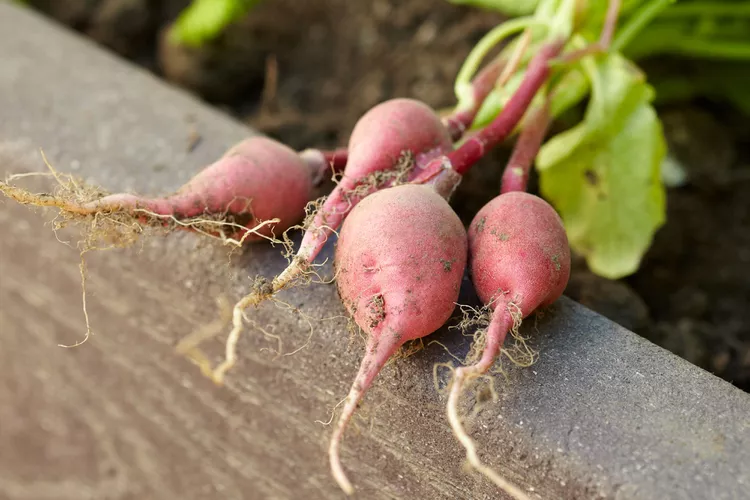Crispy, crunchy, and a little spicy, a homegrown radish is a treat. That is, if you know how and when to harvest radishes at peak flavor and size. Spring radishes are typically planted outdoors as soon as the ground is workable, while winter radishes are grown in fall gardens and harvested just in time for winter storage. To get the best flavor and texture out of either of these crops, use this guide to harvest radishes at the right time and store them correctly to maintain freshness.
When to Harvest Radishes
Radish varieties grow at different rates, so reading the seed packets carefully is important to determine how long the radishes need to grow. Fast-growing radish varieties, like ‘Cherry Belle’, can be harvested in just three weeks, while winter radishes, like ‘Watermelon’, need to grow for about 50 to 70 days. Mark when you plant radishes on your calendar or in your garden journal to keep track of your harvesting schedule so you can always pick these piquant little roots on time.
Spring radishes are usually ready to be picked in late spring to early summer before the summer heat sets in. These tender radishes should be harvested as early as possible because the roots can become pithy, cracked, and bitter if left in the garden too long. Winter radishes are much more forgiving and can be harvested well into fall if the ground isn’t frozen.
Most spring radishes are harvested in a short period, and the plants bolt and begin to flower when summer temperatures arrive. However, you can extend your radish harvest by succession planting radishes every two to three weeks from early to late spring.
How to Tell When Radishes Are Ready to Harvest
Radishes do most of their growing beneath the ground, which can make it hard to tell if they are ready to harvest. Picking radishes before they’re mature is a recipe for disappointment because immature plants typically have a mass of leaves and only thin roots. However, you can determine whether it’s time to harvest your radishes in a few easy ways.
1. Inspect the leaves.
Radish leaves grow in proportion to the roots, and the length of radish leaves can give you a hint of what’s going on beneath the soil. When radish leaves are 6 to 8 inches tall, there’s a good chance the radish roots are ready to pick.
2. Look for radish shoulders.
The tops of radishes, also known as “shoulders,” start to press against the soil surface when they near maturity. If you see radish shoulders or feel them just below the soil, it is probably time to harvest the radishes.
3. Pull up a test radish or two.
If you suspect your radishes are ready, gently tug up one or two radish plants and inspect the size of their roots. Most spring radishes are mature when they’re about 1 inch in diameter, while long, tapering radishes, like daikons, should be picked when they’re as wide as your thumb.
How to Harvest Radishes
Once radishes are a harvestable size, it’s time to start picking. Small spring radishes can be pulled up by hand by grabbing their leaves in your fingers and giving the roots a gentle twist in the soil. Longer, daikon-type radishes may need more coaxing, but they’ll usually pull right up if you loosen the soil with a hand trowel or gardening fork first. Just be careful with radishes that have long roots so you don’t break off part of them in the soil.
If you missed the harvesting window and your radishes have bolted, there is a silver lining. Radish seedpods are edible and taste just like radish roots. Break off the tender seedpods with your fingers and add them to salads for extra crunch and flavor.
Storing Fresh Radishes
After harvesting radishes, clip the greens from the roots and cut away the threadlike root tip on the end of each radish bulb. Give the roots and greens a thorough wash and wait for them to dry completely before storing them in your fridge.
Fresh radish roots and greens should be stored separately in resealable plastic storage bags or plastic containers with a damp paper towel. When stored in this manner, greens stay fresh for about three days, while the roots of spring radishes last for one to two weeks. Winter radishes have thicker skins, and they store best in root cellars, where they can keep for three to four months.
For longer-term storage, radishes can be blanched and then frozen in airtight bags, or they can be pickled, canned, or fermented.
Troubleshooting Your Radish Harvest
Radishes are beginner-friendly vegetables that usually produce a high yield of edible roots with minimal fuss. However, radish roots sometimes don’t fill out correctly, leaving you without much of a harvest. To correct this problem, you first need to determine what’s ailing your plants:
Temperature stress. Radishes are cool-weather crops and won’t grow well in hot temperatures. If you plant radishes too late in spring, they may bolt before their plump roots develop. To avoid this, sow radish seeds as early as possible in the season.
Water stress. Dry soil can impair root development, while moist soil encourages radishes to grow bigger. If you often forget to water your garden, you may want to install a drip irrigation system to provide consistent water to the plants as they grow.
Overcrowding. Like other root vegetables, radishes can suffer from overcrowding; their roots won’t develop if plants are grown too closely together. For best results, plant radish seeds 1 inch apart and then thin the seedlings to 3 inches apart after they develop two sets of true leaves.
Fertilizer issues. High-nitrogen fertilizers are not the best choices for radishes, because these fertilizers encourage leafy growth at the expense of radish roots. Instead, use compost, aged manure, or a balanced, organic fertilizer to feed your radishes, all of which support the growth of both leaves and roots.




















